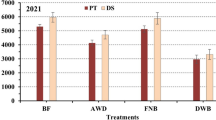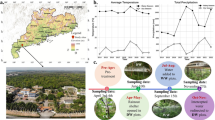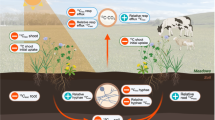Abstract
Aims
An accurate understanding about the variation of sap flow and the interaction mechanisms of sap flow with environmental factors is essential when carrying out vegetation restoration projects in areas where rainfall is limited.
Methods
A thermal dissipation probe (TDP) measured sap flow of Salix matsudana, growing in typical sandy and loess soils in the same semi-arid watershed on the Loess Plateau, China in 2012 and 2013 from May to October.
Results
Similar sap flow diurnal variation patterns occurred for both soils but, based on the sap flow, the calculated total transpiration of S. matsudana growing in the loess soil was about five times greater than that growing in the sandy soil due to differences in the sapwood cross-sectional area. Soil texture affected both the vertical distribution of S. matsudana fine roots and the soil water cycle, which led to the S. matsudana growing in the sandy soil being subjected more frequently to drought stress that stunted its growth. In contrast, S. matsudana grew well in the loess soil.
Conclusions
Soil texture was the key factor responsible for the discrepancy in the total sap flow of S. matsudana in the study region due to its effect on soil water content. Therefore, if afforestation is planned for this or similar regions, soil texture should be taken into account.










Similar content being viewed by others
References
Allen RG, Pereira LS, Raes D, Smith M (1998) Crop Evapotranspiration: guidelines for computing crop water requirements - FAO irrigation and drainage paper 56, vol 300. FAO, Rome, p 6541
Cermak J, Cienciala E, Kucera J (1995) Individual variation of sap-flow rate in large pine and spruce trees and stand transpiration: a pilot study at the central NOPEX site. J Hydrol 168:17–27
Chang XX, Zhao WZ, Zhang ZH (2014) Radial pattern of sap flow and response to microclimate and soil moisture in Qinghai spruce (Picea crassifolia) in the upper Heihe River Basin of arid northwestern China. Agric For Meteorol 187:14–21
Chang XX, Zhao WZ, Zhang ZH, Su YZ (2006) Sap flow and tree conductance of shelter-belt in arid region of China. Agric For Meteorol 138:132–141
Chen HS, Shao MA, Li YY (2008) Soil desiccation in the Loess Plateau of China. Geoderma 143:91–100
Dawson TE, Burgess SSO, Tu KP, Oliveira RS, Santiago LS, Fisher JB, Simonin KA, Ambrose AR (2007) Nighttime transpiration in woody plants from contrasting ecosystems. Tree Physiol 27:561–575
Dong XJ, Zhang XS (2000) Special stomatal distribution in Sabina vulgaris in relation to its survival in a desert environment. Trees 14:369–375
Dodd MB, Lauenroth WK (1997) The influence of soil texture on the soil water dynamics and vegetation structure of a shortgrass steppe ecosystem. Plant Ecol 133:13–28
Du S, Wang YL, Kume T, Zhang JG, Otsuki K, Yamanaka N, Liu GB (2011) Sapflow characteristics and climatic responses in three forest species in the semiarid Loess Plateau region of China. Agric For Meteorol 151:1–10
Ewers BE, Oren R, Phillips N, Stromgren M, Linder S (2001) Mean canopy stomatal conductance responses to water and nutrient availabilities in Picea abies and Pinus taeda. Tree Physiol 21:841–850
Fan J, Shao MA, Wang QJ, Jones SB, Reichardt K, Cheng XR, Fu XL (2010) Toward sustainable soil and water resources use in China’s highly erodible semi-arid Loess Plateau. Geoderma 155:93–100
Fu BJ, Chen LD, Qiu Y, Wang J, Meng QH (2002) Land use structure and ecological processes in the Loess Hilly Area. Chinese Commercial Press, Beijing (in Chinese)
Gale MR, Grigal DK (1987) Vertical root distributions of northern tree species in relation to successional status. Can J For Res 17:829–834
Granier A (1985) Une nouvelle méthode pour la mesure du flux de sève brute dans le trons des arbres. Ann Sci For 42:193–200
Granier A (1987) Evaluation of transpiration in a Douglas fir stands by means of sap flow measurements. Tree Physiol 3:309–320
Granier A, Huc R, Barigah ST (1996) Transpiration of natural rain forest and its dependence on climatic factors. Agric For Meteorol 78:19–29
Granier A, Loustau D, Breda N (2000) A generic model of forest canopy conductance dependent on climate, soil water availability and leaf area index. Ann For Sci 57:755–765
Greenwood EAN, Beresford JD (1979) Evaporation from vegetation in landscapes developing secondary salinity using the ventilated-chamber technique. I. Comparative transpiration from juvenile Eucalyptus above saline ground-water seeps. J Hydrol 42:369–382
Guan DX, Zhang XJ, Yuan FH, Chen NN, Wang AZ, Wu JB, Jin CJ (2012) The relationship between sap flow of intercropped young poplar trees (Populus Euramericana cv. N3016) and environmental factors in a semiarid region of northeastern China. Hydrol Process 26:2925–2937
Hacke UG, Sperry JS, Ewers BE, Ellsworth DS, Schafer KVR, Oren R (2000) Influence of soil porosity on water use in Pinus taeda. Oecologia 124:495–505
Hou QC, Han RL, Han SF (1999) The preliminary research on the problems of soil drying in artificial forest and grass land in the Loess Plateau. Soil Water Conserv China 5:11–14 (in Chinese with English abstract)
Huang L, Zhang ZS, Zhou XK (2011) Stem sap flow of Caragana korshinskii and its influence factors in a re-vegetated desert area. J Desert Res 31(2):415–419 (in Chinese with English abstract)
Huang YQ, Zhao P, Zhang ZF, Li XK, He CX, Zhang RQ (2009) Transpiration of Cyclobalanopsis glauca (syn. Quercus glauca) stand measured by sap-flow method in a karst rocky terrain during dry season. Ecol Res 24(4):791–801
Huber B (1932) Beobachtung und Messung pflanzlicher Saftströme. Ber Dt Bot Ges 50:89–109
Hultine KR, Koepke DF, Pockman WT, Fravolini A, Sperry JS, Williams DG (2006) Influence of soil texture in hydraulic properties and water relations of a dominant warm-desert phreatophyte. Tree Physiol 26:313–323
Kume T, Takizawa H, Yoshifuji N, Tanakad K, Tantasirin C, Tanaka N, Suzuki M (2007) Impact of soil drought on sap flow and water status of evergreen trees in a tropical monsoon forest in northern Thailand. For Ecol Manag 238:220–230
Ladefoged K (1960) A method for measuring the water consumption of larger intact trees. Physiol Plant 13:648–658
Laio F, Porporatro A, Ridolfi L, Rodriguez-Iturbe I (2001) Plants in water-controlled ecosystems: active role in hydrologic processes and response to water stress: II. Probabilistic soil moisture dynamics. Adv Water Resour 24:707–723
Legates DR, Mahmood R, Levia DF, DeLiberty TL, Quiring SM, Houser C, Nelson FE (2011) Soil moisture: a central and unifying theme in physical geography. Prog Phys Geogr 35(1):65–86
Li W (2004) Degradation and restoration of forest ecosystems in China. For Ecol Manag 201:33–41
Licata JA, Gyenge JE, Fernandez ME, Schlichter TA, Bond BJ (2008) Increased water use by ponderosa pine plantations in northwestern Patagonia, Argentina compared with native forest vegetation. For Ecol Manag 255:753–764
O’Brien JJ, Oberbauer SF, Clark DB (2004) Whole tree xylem sap flow responses to multiple environmental variables in a wet tropical forest. Plant Cell Environ 27:551–567
Ortuño MF, García-Orellana Y, Conejero W, Ruiz-Sánchez MC, Alarcón JJ, Torrecillas A (2006) Stem and leaf water potentials, gas exchange, sap flow, and trunk diameter fluctuations for detecting water stress in lemon trees. Trees 20(1):1–8
Pataki DE, Oren R (2003) Species differences in stomatal control of water loss at the canopy scale in a mature bottomland deciduous forest. Adv Water Resour 26:1267–1278
Peng H, Coster J (2007) The Loess Plateau: finding a place for forests. J For 105:409–413
Phillips N, Oren R, Zimmermann R, Wright SJ (1999) Temporal patterns of water flux in trees and lianas in a Panamanian moist forest. Trees 14:116–123
Reicosky DC, Sharratt BS, Ljungkull JE, Baker DG (1983) Comparison of alfalfa evapotranspiration measured by a weighing lysimeter and a portable chamber. Agric Meteorol 28:205–211
Roberts J (2000) The influence of physical and physiological characteristics of vegetation on their hydrological response. Hydrol Process 14:2885–2901
Schaeffer SM, Williams DG, Goodrich DC (2000) Transpiration of cottonwood/willow forest estimated from sap flux. Agric For Meteorol 105:257–270
Schwinning S, Sala OE (2004) Hierarchy of responses to resource pulses in arid and semi-arid ecosystems. Oecologia 141:211–220
Sperry JS, Hacke UG (2002) Desert shrub water relations with respect to soil characteristics and plant functional type. Funct Ecol 16:367–378
Steppe K, De Pauw DJW, Doody TM, Teskey RO (2010) A comparison of sap flux density using thermal dissipation, heat pulse velocity and heat field deformation methods. Agric For Meteorol 150(7–8):1046–1056
Vallauri DR, Aronson J, Barbero M (2002) An analysis of forest restoration 120 years after reforestation on badlands in the Southwestern Alps. Restor Ecol 10(1):16–26
Warton DI, Wright IJ, Falster DS, Westoby M (2006) Bivariate line-fitting methods for allometry. Biol Rev 81:259–291
Williams DG, Cable W, Hultine K, Hoedjes JCB, Yepez EA, Simonneaux V, Er-Raki S, Boulet G, de Bruin HAR, Chehbouni A, Hartogensis OK, Timouk F (2004) Evapotranspiration components determined by stable isotope, sap flow and eddy covariance techniques. Agric For Meteorol 125:241–258
Wu F, Chen YM, Yu ZH (2010) Growing season sap-flow dynamics of Robinia pseudoacacia plantation in the semi-arid region of Loess Plateau, China. Chin J Plant Ecol 34(4):469–476 (in Chinese)
Xin ZB, Xu JX, Zheng W (2008) Spatiotemporal variations of vegetation cover on the Chinese Loess Plateau (1981–2006): impacts of climate changes and human activities. Sci China Ser D Earth Sci 51:67–78
Yang DW, Shao WW, Yeh Pat JF, Yang HB, Kanae SJ, Oki TK (2009) Impact of vegetation coverage on regional water balance in the nonhumid regions of China. Water Resour Res 45:W00A14. doi:10.1029/2008WR006948
Zhang GH, Chen BF, Nie JZ, Lin MX (2007) Castanopsis jianfengensis sap flow and its relationships with environmental factors in tropical montane rainforest. Chin J Appl Ecol 18(4):742–748 (in Chinese with English abstract)
Zhang YQ, Kang SZ, Ward EJ, Ding RS, Zhang X, Zheng R (2011) Evapotranspiration components determined by sap flow and microlysimetry techniques of a vineyard in northwest China: dynamics and influential factors. Agric Water Manag 98:1207–1214
Zhou P, Liu G, Hou X (2008) Study on vegetation and soil nutrient characters of Artemisia sacrorum communities in hilly-gully region of the Loess Plateau. Acta Pratacultrae Sin 17(2):9–18 (in Chinese with English abstract)
Acknowledgments
We acknowledge funding by The National Natural Science Foundation of China (Nos. 41271239, 51239009) and CAS Action-Plan for West Development (KZCX2-XB3-13). We would like to express our gratitude to the two anonymous referees for their suggestions and helpful comments.
Author information
Authors and Affiliations
Corresponding author
Additional information
Responsible Editor: Rafael S. Oliveira.
Rights and permissions
About this article
Cite this article
Peng, X., Fan, J., Wang, Q. et al. Discrepancy of sap flow in Salix matsudana grown under different soil textures in the water-wind erosion crisscross region on the Loess Plateau. Plant Soil 390, 383–399 (2015). https://doi.org/10.1007/s11104-014-2333-0
Received:
Accepted:
Published:
Issue Date:
DOI: https://doi.org/10.1007/s11104-014-2333-0




